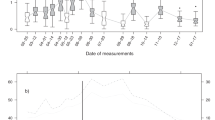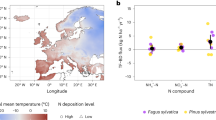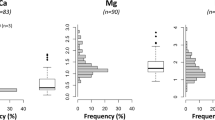Abstract
MEASUREMENTS of sulphur uptake by plants are needed to aid our understanding of the long-range transport of sulphur dioxide and the role of sulphur uptake in acidification and the nutrient balance of forest ecosystems1. The traditional profile method of analysing sulphur uptake has proved inadequate for forest measurements because the vertical concentration gradients above forests are small and difficult to measure with current techniques2; the best estimates available are based on extrapolation of measurements from individual shoots to the whole forest3. We report here the first direct measurements of the uptake of sulphur from the atmosphere by a forest in the absence of precipitation (that is, dry deposition). These measurements were possible because of the development of a fast response sulphur detector which allowed, for the first time, use of the eddy correlation method4 for sulphur uptake measurements. The sulphur uptake ranged from 0–0.1 µg m−2 s−1 (as SO2) for atmospheric sulphur concentrations up to 35 µg m−3 (expressed as SO2). On average, ∼75% of the atmospheric sulphur was in gaseous form. These uptake rates support those derived from use of the recent hypothesis that sulphur dioxide uptake by vegetation takes place through the stomatal opening for a dry canopy3. Some measurements of dry uptake of sulphur over farmland were also made and are in close agreement with published measurements made over similar surfaces using the profile and other methods.
This is a preview of subscription content, access via your institution
Access options
Subscribe to this journal
Receive 51 print issues and online access
$199.00 per year
only $3.90 per issue
Buy this article
- Purchase on Springer Link
- Instant access to full article PDF
Prices may be subject to local taxes which are calculated during checkout
Similar content being viewed by others
References
Department of Environment, Pollution Paper No. 7, Effects of Airborne Sulphur Compounds on Forests and Freshwater (HMSO, 1976).
Garland, J. A. Proc. R. Soc. A 354, 245 (1977).
Garland, J. A. & Branson, J. R. Tellus 29, 445 (1977).
Priestley, C. H. B. Turbulent Transfer in the Lower Atmosphere (University of Chicago Press, 1959).
Desjardin, R. L. & Lemon, E. R. Boundary-Layer Met. 5, 475 (1974).
Galbally, I. E. Adv. Geophys. 18B, 329 (1974).
Hicks, B. B. Boundary-Layer Met. 3, 214 (1972).
Garratt, J. R. Boundary-Layer Met. 8, 255 (1975).
Hadjitofi, A. & Wilson, M. J. G. Atmos. Envir. (in the press).
McBean, G. A. J. appl. Met. 11, 1078 (1972).
Dyer, A. J. & Garratt, J. R. J. met. Soc., Japan 56, 19 (1978).
Dyer, A. J. & Hicks, B. B. Q. Jl R. met. Soc. 98, 206 (1972).
Wyngaard, J. C. in Workshop on Micrometeorology (ed. Haugen, D. A.) (Am. Met. Soc., 1973).
Sreenivasan, K. R., Chambers, A. J. & Antonia, R. A. Boundary-Layer Met. 14, 341 (1978).
Wesely, M. L., Hicks, B. B., Dannevik, W. P., Frisella, S. & Husar, R. B. Atmos. Envir. 11, 561 (1977).
Gash, J. H. C. & Stewart, J. B. Boundary-Layer Met. 8, 453 (1975).
Author information
Authors and Affiliations
Rights and permissions
About this article
Cite this article
GALBALLY, I., GARLAND, J. & WILSON, M. Sulphur uptake from the atmosphere by forest and farmland. Nature 280, 49–50 (1979). https://doi.org/10.1038/280049a0
Received:
Accepted:
Issue Date:
DOI: https://doi.org/10.1038/280049a0
This article is cited by
-
Die Postulate von Koch und die Luftverschmutzung
Forstwissenschaftliches Centralblatt (1984)
Comments
By submitting a comment you agree to abide by our Terms and Community Guidelines. If you find something abusive or that does not comply with our terms or guidelines please flag it as inappropriate.



